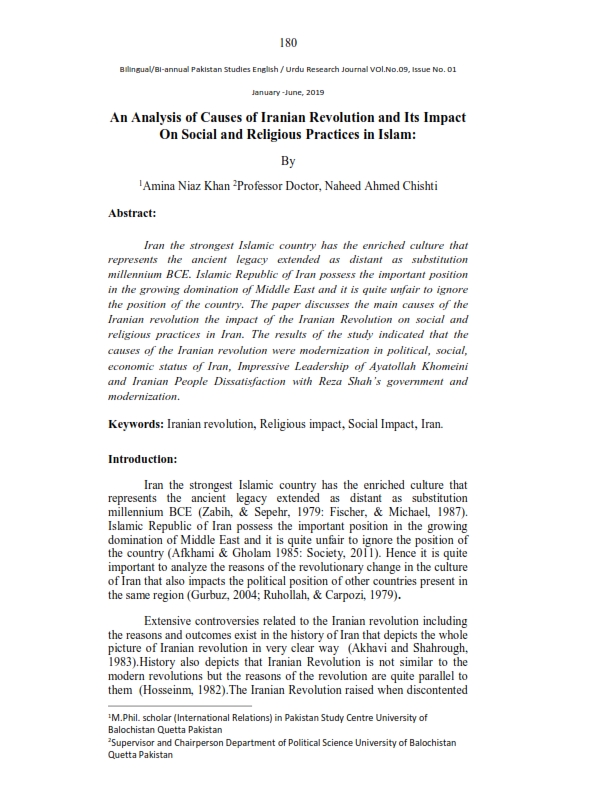An An Analysis of Causes of Iranian Revolution and Its Impact On Social and Religious Practices in Islam
Keywords:
Iranian revolution, Religious impact, Social Impact, Iran.Abstract
Iran the strongest Islamic country has the enriched culture that
represents the ancient legacy extended as distant as substitution
millennium BCE. Islamic Republic of Iran possess the important position
in the growing domination of Middle East and it is quite unfair to ignore
the position of the country. The paper discusses the main causes of the
Iranian revolution the impact of the Iranian Revolution on social and
religious practices in Iran. The results of the study indicated that the
causes of the Iranian revolution were modernization in political, social,
economic status of Iran, Impressive Leadership of Ayatollah Khomeini
and Iranian People Dissatisfaction with Reza Shah’s government and
modernization.
References
Abrahamian, E. (1980). Structural causes of the Iranian revolution. Merip
Reports, (87), 21-26.
Afkhami, & Gholam R. (1985). The Iranian Revalutian: Thanatos on a
NotionoI Scale. Washington. DC: The Middle East Institute.
Akhavi and Shahrough. (1983). "The Ideology and Praxis of Shi'Ism in
the Iranian Revolution.
Comparative Studies in Society and History, 25: 195-221.
Ansari, A. M. (2001). The Myth of the White Revolution: Mohammad
Reza Shah, 'Modernization' and the Consolidation of Power.
Middle Eastern Studies, 37, 1-24.
Amjad, M. (1989). Iran: from royal dictatorship to theocracy (Vol. 242).
Greenwood Pub Group.
Amuzegar, J. (1991). Dynamics of the Iranian revolution: The Pahlavis'
triumph and tragedy. SUNY Press.
Hosseinm B. (1982). The StQte Qnd Revalutian in Iran 1962-1982. New
York: St. Martin's Press.
Assef, B. (1987), Workers and Revalutian in Iran. New York, London:
Zed Books.
Cherly, B., & Zalmay, K. (1984). The Government of Gad, lran's Islamic
Republic. New York: Columbia University Press.
Benard, C., & Khalilzad, Z. (1986). The Government of God: Iran's
Islamic Republic (No. 15). Columbia University Press.
Cottam, R. (1989). Inside Revolutionary Iran. Middle East Journal, 43(2),
-185.
Eisenstadt, M. (2011). Iran's Islamic Revolution: Lessons for the Arab
Spring of 2011? In Strategic Forum (No. 267, p. 1). National
Defense University.
Eisenstadt, M. (1989). Syria’s Defense Companies: Portrait of a
Praetorian Unit. unpublished paper.
Fischer, and Michael M. J. (1987). Iran from Religious Dispute to
Revolution: Harvard studies in cultural anthropology, 3.
Cambridge, Mass: Harvard University Press, 1980.
Gage, N. (1978). Iran: Making of a Revolution. New York Times.
Green, J. D. (1982). Revalutian in Iran. New York: Praeger Publishers.
Gurbuz, M. V. (2004). The Iranian Revolution. Ankara Universitesi SBF
Dergisi , 58-4.
Halliday, F. (1977). Iranian Revoultion in International
Affairs:Programme and Practice. The Turkish Yearbook , XVII, 48-
Heinz. H. (1997). Shi’a Islam: From Religion To Revolution. Princeton:
Markus Wiener
Publishers.
Mary. H. (1983). Two Images of Husain: Accomodation and Revolution
in an
Iranian Village. Religion and Politics in Iran. New Haven: Yale UP, 218-
Eric, H. (1986), SociaI Origins of the Revolutionary Clergy (Syracuse
University Press)
(ed. KEDDIE, Nikki R. / HOOGLUND, Eric).
Youssefi, K. (1988). The Atliance of Social Forces in the Iranian
Revalutian. New York: Ph.D.
Dissertation at Fordham University.
Keddie, N. R. (1983). Religion and Politics in Iran: Shiʻism from
Quietism to Revolution. New Haven: Yale University Press,
Kendell, J. (1979). Iran's Students and Merchants Form an Unlikely
Alliance. New York .
Kramer, M. S. 1987), Shiʻism, Resistance, and Revolution. Boulder,
Colo: Westview Press,
Looney, R. E. (1981). The Impact of Oil Revenues on the PreRevolutionary Iranian
Economy.” Middle Eastern Studies 21: 61-71.
Sandra, M. (1998). The lranians (New York: Penguin Group).
Milani, M. M. (1988), The Making of Iran's Islamic Revalutian:
From Manarchy to Islamic Republic. London: Westview
Press.
Mansoor, M. (1993). Class, Politics, and Ideology in the Iranian
Revalutian. New York:
Columbia University Press.
Mustunsir, R. A (2012). The Iranian Revolution: The role and
conrtibution of Ayatollah a Ruuholla Khomeini. Afghan Journal
Committee 12(92) 187-190.
Pesaran, M. H. (1985). Economic Development and Revolutionary
Upheavals in Iran.” In Iran: A Revolution in Turmoil, Haleh
Afshar, ed. Albany: Suny Press.
Rouhollah R. K. (1990) . Iran's revolution: the search for consensus.
Indiana Univ Pr.
Ruhollah, K. and Carpozi. G. (1979). Islamic Government. New York:
Manor
Books.
Rubin, B. M. (1980). Paved with good intentions: The American
experience and Iran. New York: Oxford University Press.
Salehi, M. M. (1997). Insurgency Through Culture and Religian, the
Islamic Revalutian of Iran (New York, London: Praeger).
Shahi, A. (2009). Thirty years on: The Iranian revolution and its impact
on the region
[Online]. London UK: E-International Relations (E-IR). Available:
http://www.eir.info/2009/02/14/thirty-years-on-the-iranian-revolution-and-its-impacton-the-region/ [Accessed 03-02 2012].
Skocpol, T. (1994). Social revolutions in the modern world. Cambridge
University Press.
Society I. C. “B” (2012). White Revolution the post-Mosaddeq era and
the Shah's White Revolution In: SOCIETY, I. C. (ed.) History of
Iran. Tehran: Iran Chamber Society.
Society, I. C. “A” (2012). History of Iran:Mohammad Reza Shah Pahlavi
Arya Mehr and Shahanshah (King of the Kings) In: SOCIETY, I.
C. (ed.) History of Iran. Tehran, Iran: Iran Chamber Society.
Society, I. C. (2011). History of Iran Ayatollah Khomeini Ayatollah
Rouhollah Mousavi Khomeini (Imam Khomeini) In: SOCIETY, I.
C. (ed.) History of Iran. Tehran, Iran: Iran Chamber Society.
Weber, and Max, S. N. (1968). Eisenstadt. Max Weber on Charisma and
Institution Building;
Selected Papers. The Heritage of sociology. Chicago: University of
Chicago Press.
Zare, H., Trujillo, A. J., Driessen, J., Ghasemi, M., & Gallego, G.
(2014). Health inequalities and development plans in Iran; an
analysis of the past three decades (1984–2010). International
Journal for Equity in Health, 13, 42. http://doi.org/10.1186/1475-
-13-42.
Zabih, S. (1979). lran's Revalutianary Upheaval. San Francisco: Alchemy
Books.



